Centrifugal Chillers
Posted by lorne, 26th July, 2012 10:50 am
HVAC (Heating ventilation and air conditioning system) consumes almost 60 % of the total building energy. In case of central air conditioning system the central cooling plant known as chillers consumes more than 50 % energy. Hence for energy efficient design of HVAC system, it is crucial to select right type of chiller.
There are different types of chillers available in the market such as reciprocating, scroll, screw, centrifugal chillers. In these types, the reciprocating chiller is on the verge of becoming obsolete due to high power consumption and high maintenance cost. For commercial building with floor area roughly above 100000 Square feet, centrifugal chillers are widely selected due to their high efficiency. The power consumption of a centrifugal chiller is approximately 0.5 to 0.6 IKW/TR at ASHRAE design conditions. The air cooled screw chiller consumes almost double the power compared to a centrifugal chiller. The main disadvantage of using centrifugal chillers is the compressor surging at low load, which can be overcome by using variable frequency drive (VFD) for compressor motor and hot gas by pass method(although hot gas bypass is not the right method from an energy efficiency point of view)
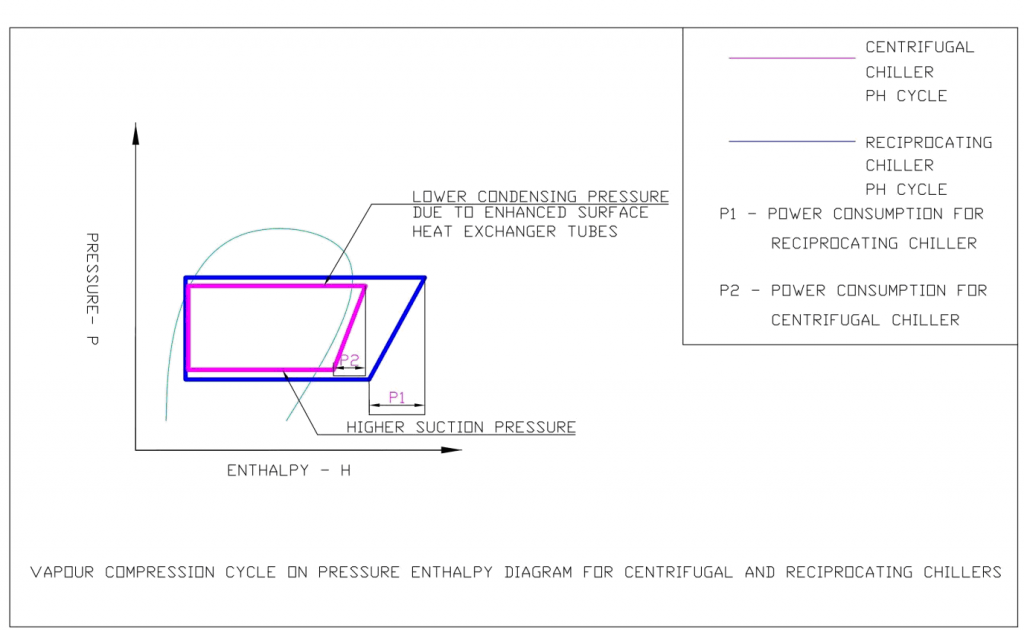
The centrifugal chillers can be used with refrigerant R 123 and R 134a. R 134a is HFC (Hydro Fluro Carbon) hence has no phase out schedule as per Montreal Protocol, which emphasis on ozone depletion potential. This is crucial to LEED’s credits for refrigerant management. Without meeting the Fundamental Refrigerant Management Pre-requisite, a building is not eligible for LEED certification. However it has high global warming potential hence as perKyotoprotocol this refrigerant has phase out schedule. The other refrigerant R123 is HCFC (Hydro Cloro Fluro Carbon) which has less ozone depletion potential and has phase out schedule as per Montreal Protocol.
GreenBuildingrating system mentions minimum limit on COP (coefficient of performance) which can be achieved by right selection of centrifugal chiller.
The future of centrifugal chiller design lies with latest technologies such as oil free magnetic bearing technology, high efficiency heat exchanger with enhanced surface copper tubes, controls compatible with building management system. 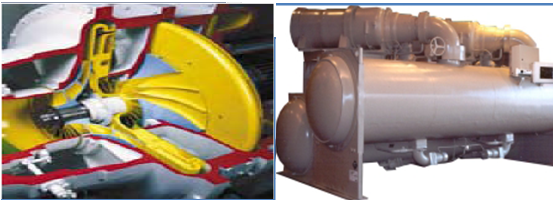
Dual Compressor Centrifugal chiller working on R134a refrigerant
Heating and Cooling THE RIGHT WAY
Posted by lorne, 23rd July, 2012 10:48 am
Chillers and Heat pumps work on the same principles of vapour compression cycle. The chiller operates at 12/7 deg C(54/44 deg F as per ASHRAE standards) chilled water in /out temperature and heat pump operates at lower evaporating temperature depending on the ambient temperature and high condensing temperature required for winter heating.
The following different options are available for winter heating:
1. A reversible heat pump works as a chiller during summer conditions, which produces chilled water at 12/7 deg C ( 54/44 deg F as per ARI conditions) .During winter conditions the refrigerant flow direction is reversed ,the evaporator becomes condenser and rejects the heat inside conditioned space for heating. Waste heat source can be used to achieve the maximum efficiency of the heat pump. Different types of heat pumps like gas fired heat pump, geothermal heat pump are used.
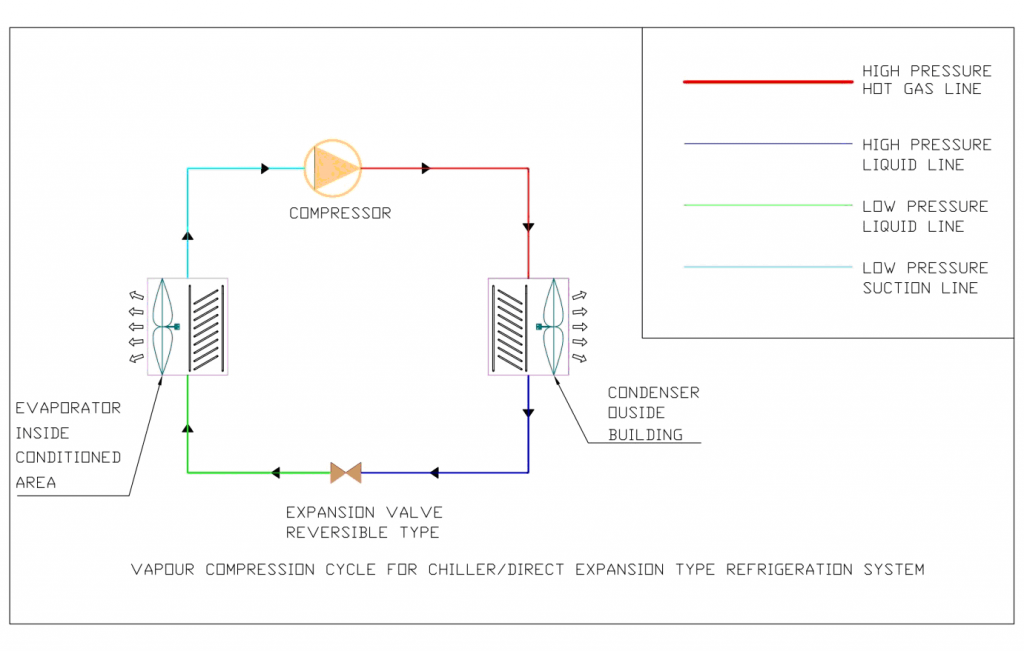
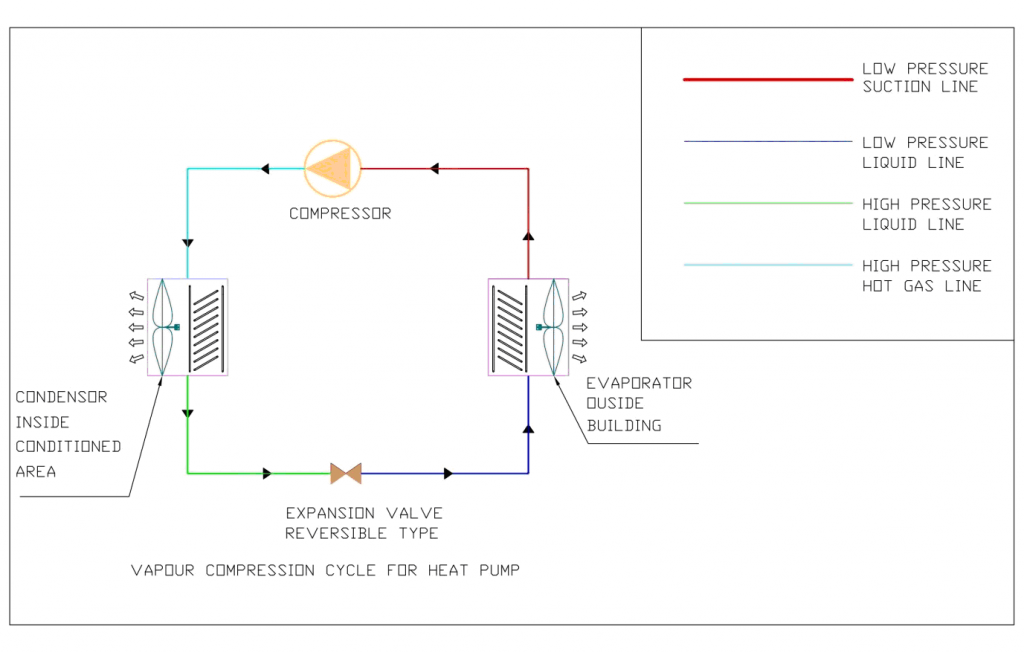
2. Electric heaters which are placed inside conditioned space. A 1 KW space heater produces less than 1 KW of heat. The heat pump with 1KW of input power can produce as high as 4 KW of heat.
3. Steam /water Boiler with circulating pumps and indoor units/Air Handling units for heating. This option can become viable for large residential /commercial building where central boiler for heating is used.
Following is detailed comparison of electric heater/heat pump/boiler for winter heating:
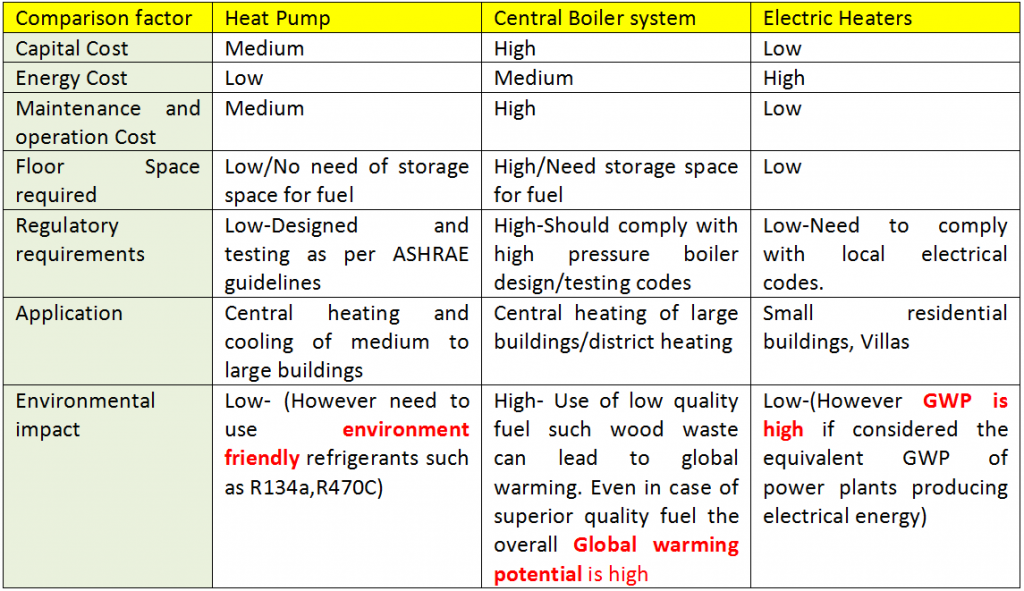

Toronto Condo Boom!
Posted by lorne, 16th July, 2012 3:34 pm
Lots of talks are happening around regarding future of condo market in Canada especially in world-clasc cities such as Toronto. The Condo market in Toronto has seen a boom in last few years due to following factors:

• Single family homes are in short supply in downtown area hence the prices for the same are sky rocketing. People are looking for more economical options and condos have proved to be the obvious, and frankly only choice.
• The demography of Canada is changing at a fast rate, the age group between 20 to 44 years, which is target market for condos is growing at faster rate compared with other metros from developed countries.
• Toronto Condominiums are a safe-haven for foreign investment and a secure place to see their money appreciate over time.
• To provide the boost to this sector, Government has adopted a policy of lower interest rates.
• The Canadian Government is keen on preserving the green land. This has led to additional floors on existing condos. Essentially, in downtown Toronto, there is no such think as a Greenfield
• Investors looked at it as a high return investments compared to capital market. Investors could get high returns as rents are high and interest rates are low.

Emotions also play an important role in any type of market and some fractions of the media has been creating a sentiment that the condos market bubble in Toronto is going to burst. On the other hand developers are assuring good returns from Condo market. Many economists have predicted that an increase in interest rates will have a negative impact on growth of condo market. However this will all depend on how the overall economy of the region is performing. A large number of employees in Canada work for financial services, Business services, Life sciences, green technology sectors. There is no reason that these sectors will see big downslide in near future. The countries like United Sates are showing good signs of growth in GDP. The Ontario merchandise export to United States has increased by almost 7-8 % in year 2011/12.
In worst case scenario the sharp increase in interest rate will reduce the demand of condos and create more default payments due to increase in EMI. As the supply will exceed demand, the prices will fall. Even if banks want to liquidate the properties, they will not have buyers who can pay mortgage amount. Hence the banking system will suffer badly. The government can’t afford to let this to happen. It will either take corrective action by reducing interest rates or by providing financial aid to the sector.
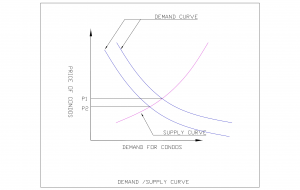
Condos market may see temporary drop in prices but it is going to be an investor’s hot destination on long term basis. Personally, we would like to see a lower sloped rise in Condo prices, as this will be a much more sustainable market as opposed to the exponential-seeming trend of recent prices.
21 Years of Green Building
Posted by lorne, 19th June, 2012 7:40 pm

Happy Birthday to You
Happy Birthday to You
Happy Birthday Dear Lorne
Happy Birthday to You.
As these ever so familiar words are sung to me for the 21st time in my life, I cannot help but wonder how far the green building industry has come since I was brought into this world.
After doing some research and reading scholarly articles that shared my year of birth, I have come to the conclusion that not much has changed. There have been no fundamental changes to the ideals of green building and design in the past 21 years. From holistic approaches to net-zero emissions in every sense of the word, the theory had already been developed. The only change through my entire life has been its implementation, which is above all the most important.

LEED has certainly been a tremendous tool in increasing the feasibility of those ideas and theories. Upon reflection, the ideals are pretty simple, produce more or as much as you consume. LEED continues to grow and will eventually achieve this ideal and change the ways of our built-environment.
Nevertheless, it boggles my mind that these simple better building practices have not been fully implemented in the second decade of the 21st century. Over two decades have passed and humanity has been unable to consume less or equal to that of what we produce, be it energy, food or resources. This has been achieved by so many other generations and nearly every species on the Earth at some point in time. After all, we are the only species to ever burn in order to create and meet the needs we have set for our-self. Albeit, I have faith in society and humanity’s slow recognition to take responsibility for everything we have artificially created on this planet.
LEED taps into humanity’s mental priorities ($ / People / Earth), the triple-bottom-line. The desire to protect the Earth’s environment for future generations will motivate people to realize our rate of consumption is simply too high and not viable. Our built-environment is the end consumer of so many of our planet’s precious resources and we in the industry must address this ongoing concern. As time progresses we must shift more and more eyes to a new path of sustainable construction and consumption.
Sincerely,
Lorne Mlotek
LEED AP BD+C
June 19, 2012
LEED 2012, NOW LEED V4 POSTPONED!
Posted by lorne, 5th June, 2012 2:34 pm
From the time when LEED 2012’s release date was announced to actually be in 2012, an immense amount of commentary was buzzing through the Green Building World. That commentary was geared at the idea of “Too fast, Too Soon,” and was answered by the USGBC on June 4, 2012 when they announced LEED 2012’s release will be postponed until ~late 2013.

The debate to post-pone LEED 2012 was spear-headed by Robert Watson, Father of LEED and discussed on Leeduser.com. The debate was not if changed is needed, but rather when to change.
Earlier this week I stated my 2cents on the debate:
” While I agree with the initiative of the USGBC as well as many of the proposed credits, I believe trying to push this through too quickly would only cause difficulties for this fast-growing industry.
1. From a consulting/designing perspective:
Many of the on-going projects at our firm are currently still in the midst of submitting LEED NC ~1.0-2.2 documentation of certification. Our LEED 2009 projects are still just getting off the ground and realistically, I can see many of them continuing into the latter part of this decade. Many employees just get confused at times between the subtle differences in credits. If we were to introduce another version of LEED to the workplace, juggling 3 would be a little more inconvenient, to say the least. I also wanted to note that the clients/developers we work with are just becoming familiar with LEED 2009 and can comfortably hold their own during in-depth credit discussion with the LEED consultant. These guys don’t work with LEED everyday as some of us do, a new version of LEED would make other stakeholders less comfortable in sustainable talks.
2. I also teach courses for LEED GA/AP BD+C exam prep.
When the switch is made from 2009 to 2012, all those writing the 2012 exam will likely be studying credits that are not currently used in the real world, but will be used in the future instead, making their new-found credential achievement less applicable to the present time, and a hindrance to the employer+ employee.
With that said, while I understand that a new version of LEED is needed to progress sustainability in the built environment, I do not believe that it is imperative to implement LEEDV4 immediately, agreeing with Rob.”
This Extra time will allow the U.S. GBC to examine and further improve some vital areas in the new Rating System.
1. Allow for further Beta Testing of the new rating system to visualize the realistic impact and challenges of implementing this new rating system. Karen Joslin of Joslin Consulting even suggests paying beta testers to receive worthy feedback.
2. Fix the Materials and Resources Credit Category, a source of ample commentary due to its drastic variations.
3. Upgrade tools such as LEED Online to be ready for new credits, traffic and submissions.
4. Address: Occupants reduction of energy internally, Efficient envelope design and proper building orientation to a greater extent.
LEED v3 (2009) will be available for another 3 years.
Cheers,
Lorne Mlotek
LEED AP BD+C














